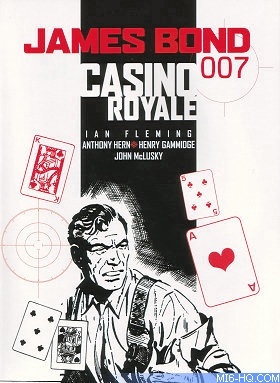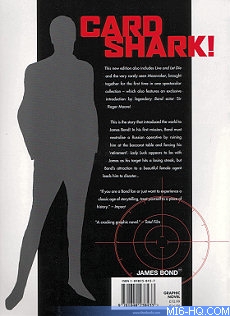 |
| |
MI6 reviews Titan Books' reissued graphic novel
"James Bond 007: Casino Royale" by Ian
Fleming, Anthony Hern, Henry Gammidge and John McLusky.
| |
"James Bond 007: Casino Royale" Review
24th December 2006
In the early 60's James Bond gripped the World. He was everywhere,
including national newspapers. Over the past few years, Titan
Books have republished the original classic Express strips -
and one of the most popular volumes was "Casino Royale".
Bringing the daily Bond back to the public in this timeless
form
meant the strips saw Bond fighting his foes in three panels,
and on the odd occasion two. Due to the unique structure of the
comic
strip, each had to be carefully crafted to clearly communicate
location, plot and character development to the reader.
February 2005 saw the launch of the reissued Anthony Hern, Henry
Gammidge and John McLusky original set of graphic novels based
on Ian
Fleming's
first Bond novel published in 1953. With the latest James Bond
film going back to Fleming’s first novel, now seems the
ideal moment to revisit the comic strip version of Casino
Royale.
It was the first Bond adventure to be adapted to the format,
and originally serialised in the Daily Express in 1958. The volume
also contains Live And Let Die and Moonraker.
|
One thing that really stands out about Casino Royale is that it is plainly
an old-fashioned espionage yarn. Bond’s mission is simple; to score a
propaganda victory against the Russians by discrediting Le Chiffre, the villain
in their pay. Simple assassination is ruled out because of the risk of turning
Le Chiffre into a martyr, but he has lost Russian provided funds in a bad personal
investment. The British secret service, backed up by the French and Americans,
send their best gambler to try and bankrupt Le Chiffre, thereby preventing
him from winning back the missing money.
Ian Fleming's masterstroke was to dress up this rather humdrum
plot with the glamour of the high life and thrill of the
casino. And while a large part of Bond is Ian Fleming, or
at least a romanticised version of him, some of the larger-than-life
characters that Fleming had come across during the war must
have also come to mind; people like “Biffy” Dunderdale,
the SIS station chief in Paris, who used to dash about in
a bullet proof Rolls-Royce and financed his spying operations
out of his own pocket, certainly seem to have possessed something
genuinely Bondian about them.
|
|

Above: Front cover |
The comic strip is largely faithful to the original story and
the artwork is well drawn, although it takes some time before
McLusky decides what his James Bond actually looks like - his
appearance is quite changeable to begin with, but has settled
down by the end of the story. It is also notable that M is always
hidden by shadow or seen from behind.
 Above: The opening panel of "Casino
Royale"
Above: The opening panel of "Casino
Royale" |
Although the book starts with Bond in the casino ("The
scent and smoke and sweat of a casino are nauseating at three
in the morning") as he mentally sums up his mission to date,
the comic follows a completely linear path - quite rightly
so as this literary trick would not work nearly as well in comic
format.
One slight change in the plot is that Vesper is introduced
earlier than in the novel - in fact similar to the film. This doesn’t
serve any purpose and it is difficult to see what the writer,
Anthony Hern, gained by this change, but it doesn’t detract
from the story either.

Above: Bond is captured by Le Chiffre
after beating him at the casino. |
|
Some other small details
are also changed - in 1958 it wouldn’t have
been acceptable in a daily newspaper for Le Chiffre to
invest in chain of brothels as he does in the novel; rather
more obliquely he invests in a chain of “questionable
clubs". And for some reason when James Bond tells
the casino barman how to mix his drink - he later
christens it the Vesper after the heroine - he specifies
vermouth rather than Kina Lillet.
When it was first announced that Bond
21 was to be Casino Royale the Bond fan community was
buzzing with two questions:- would the infamous carpet
beater scene make it into the film and would the downbeat
ending with Bond’s harsh words - "the bitch
is dead" - appear in the script?
|
These are also relevant to the comic strip, published in an
age when the James Bond books were often seen to overstep the
mark. Bond’s torture does involve a carpet beater, although
you’ll have to judge whether it was applied so severely
as in Fleming’s original. And Bond’s final words
about Vesper were toned so as to be suitable for a daily newspaper.
 Above: McLusky's vision of the
Moonraker rocket gives a grand sense of scale.
Above: McLusky's vision of the
Moonraker rocket gives a grand sense of scale. |
Sir Roger Moore - Introduction
The third official James Bond actor was chosen to introduce "Casino Royale",
due to the volume's inclusion of "Live And Let Die" and "Moonraker"
- his debut and fourth 007 outings respectively. Sir Roger gives a brief account
of his experience on both films, and the major differences between Fleming's
novels and the cinematic adaptations he starred in.
"Bond has been a big part of my
life... and I for one am very grateful that fifty-odd years
ago, Ian Fleming sat down in his Jamaican home and started
typing the first
page
of Casino Royale- Sir Roger Moore 2005
Bond In Books (Part 5)
Paul Simpson takes a look back at the period between Ian Fleming's
"Octopussy & The Living Daylights" being published posthumously
and John Garden starting his era as continuation novelist in
the only special feature of this volume. The three page feature
delivers a brief account of Kingsley Amis' work on "Colonel
Sun" and
"The
Book
of Bond",
as well
as John
Pearson's
"The
Authorized Biography of 007".
The Complete James Bond Syndicated Newspaper
Checklist
Rounding off this reissue is a checklist of every Bond newspaper
strip including dates of print and reference numbers in a table
format.
James Bond will return in 2007 in The
Phoenix Project...
 |
|
Summary
All in all Casino Royale is a fast moving story and despite
Bond’s appearance being rather changeable to start with,
the artwork and story work together well to the action. McLusky's
style stabilises through "Live And Let Die" and produces some
of the most iconic visuals from the comic-strip series in "Moonraker".
The device of using Bond as a narrator in the stories begins
to jar by the third outing, but this would be dropped in
later strips.
The special features are limited to the
"Bond In Books" piece, which is merely a stop-gap between
the coverage
of Fleming and Gardner. Little fresh insight is given to
this period of uncertainty in the literary series. Sir
Roger Moore's introduction is actually well placed in the
series, but the text does not read as if it came
from the lips of the longest running 007 actor.
The quality of the artwork is excellent throughout, and
Titan must be commended for preserving these classic stories
in such good condition.
|
| Adaptation |
 |
| Artwork |
 |
| Features |
 |
| Overall |
 |
Thanks to David Leigh. Images courtesy Titan Books and Amazon
Associates.